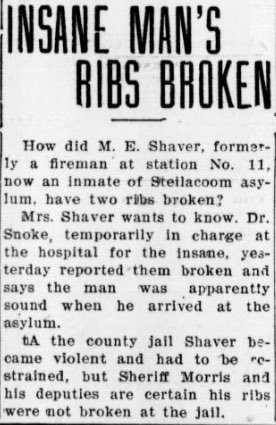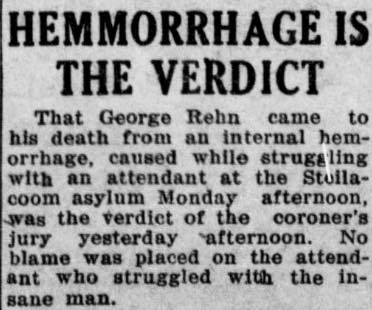
The Fort Steilacoom Asylum, later known as the Western State Mental Hospital, was a place of greed, captivity, and abuse. While the old asylum is nothing more than ruins today, in its height it was a formidable building that, upon sight, gave its victims an overwhelming sense of hopelessness.

“Borrowed” Money From Inmates
When inmates were taken into an asylum, all of their personal possessions, including money, were taken from them, just like they do today. The asylum would then store the items away and place the money into a safe until the patient was released. However, back in 1905, the Steilacoom Asylum found all that money to be a little too tempting.
Ninety-two acres went up for sale. Since the land was next to the asylum’s property, it seemed like it would be a great addition. The only problem was that the asylum was $900 dollar short and was not able to get that money from any other sources, except for one.
Without saying a word to anyone or asking the inmates for their permission, the asylum workers opened up the safe set up for the patients and took out the $900. No one would have known about the “borrowing” if it had not been marked in the monthly financial statement of the asylum as “Receipts, contingent fund. Borrowed from inmates.”
Two months after the borrowing, the news hit a Washington state newspaper where it was admitted that the asylum had no plans in place to return the money to the inmates. [1]

Guardianship Was Profitable
A “crazy” person’s money did not always wind up in the asylum’s safe. Sometimes it ended up in the hands of a court appointed guardian.
In 1906, Ferdinand Schlenter left his home in Potter County, South Dakota to travel the cities along the West Coast. However, while he was in Seattle, he was arrested because a police officer thought the aged man was acting rather peculiar.
Ferdinand was immediately taken before a judge, but, in his stubbornness, Ferdinand refused to answer most of the judge’s questions. For his insubordination, Ferdinand was examined by the asylum doctors who then claimed that the man was suffering from religious mania and had homicidal tendencies.
Twelve days after Ferdinand was thrown into the Steilacoom Asylum, a local Republican politician came forward and had a judge approve his guardianship over Ferdinand. While the politician did not personally know Ferdinand, he was aware that Ferdinand had $849.40 in his possession. As Ferdinand’s guardian, the politician was given the inmate’s money for “safe keeping.”
Ferdinand spent three years in the asylum until friends of his from South Dakota located him. Apparently, Ferdinand owned about 900 acres of farmland and a home. He had money, and his friends had to travel all the way to Washington state, with an attorney, to get custody of him.
It was not easy, of course. The politician did not want to give up his ownership of the old man, but eventually a judge handed Ferdinand over to his friends. The money, naturally, was not returned. [2]
Send Gifts to the Inmates
As if taking money away from the inmates was not enough, the head of the asylum also thought it was appropriate to ask people to send in gifts at Christmastime.
In 1912, an article appeared in the local newspaper stating that the head of the asylum was asking all locals to send something to the asylum:
“Dr. Calhoun asks that all money or presents be sent to the superintendent… and he will see to its bestowal on the inmates.”
Inmates were not allowed to have money, so why claim that it was going to be bestowed upon the patients? It all sounds rather fishy, but it must have been profitable because the hospital in 1913 asked for gifts again. The only difference was that in 1913, the good doctor was asking for people to send those gifts of money a little earlier than last year. [3] [4]

Love and Heartbreak
Emma Bremer felt that she was all alone in the world. At the age of 21 in 1914, she was homeless and broke, but her story was not unusual for that time period.
Emma came to the United States from eastern Canada. She had been forced to marry at the tender age of 15 to a man who was in his thirties. During the marriage, her husband would often beat her with a strap. Once she became so terrified that she ran away from him, but she was quickly recaptured and returned to him for another brutal beating. The second time she ran away, she was too scared to stay in Canada and had made her way to Washington state.
Being eager to start a new life, Emma quickly found work at a hotel in Seattle. That is where she met a young man named Jack. A relationship formed between them and he soon asked her to marry him. Sadly, Emma had to decline the offer. After all, she was still married in Canada and her church frowned upon divorce.
With an aching heart, Emma made plans to face her fate in Canada. She rented a room for the night, but the landlady decided that the young woman was acting strange and phoned the police.
All it took was that one phone call to land Emma in the local insane asylum. She was quickly examined by the sanity commission and the doctors agreed that she was suffering from “acute melancholia.”
News of Emma’s story quickly hit the local newspapers and the public was outraged that a young woman, suffering only from heartbreak, was placed in a hospital for the insane. As an excuse, the asylum’s superintendent said, “We have many patients, among them women and girls, who should not be here if there were any other place to send them.” [5]

Brutal Captivity
The story of Alice Vinsot hit the front page in 1913. According to reports, Alice was held prisoner inside the Steilacoom Asylum for six long years:
“[She] was kept housed, not even allowed to go out into the ground. Caged like a beast and kept excommunicado. She was not allowed to see friends. She was not allowed to write letters outside. She was denied legal counsel, denied exercise, denied reading matter, and allowed just to sit with the demented on a bench and look at the bare walls of the crazy house.”
For years, Alice wrote letters asking for help and dropped them out of the windows until one day someone picked up one of her letters and took it to someone who could help the inmate.
An attorney was hired for Alice and, after a court battle, she was declared sane and released.
How did Alice get sent to the asylum in the first place? A relative of hers grabbed her one day and took her to the asylum. She was declared insane on the spot and it is assumed that the relative took possession of her home and valuables because nothing of hers was left after her release. [6]

